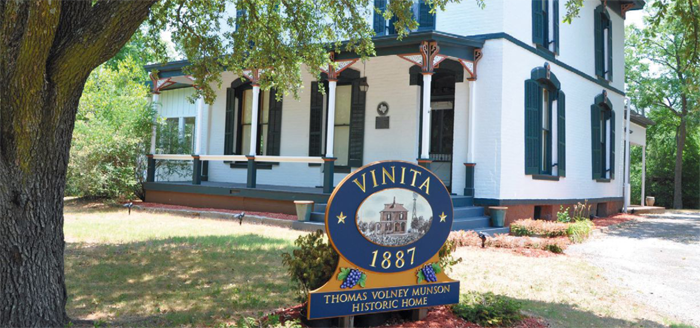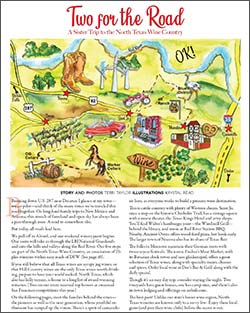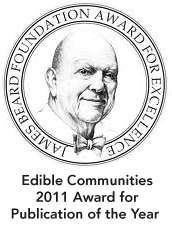
Editor’s Note: In the late 1800s, T. V. Munson of Denison brought Texas worldwide acclaim when he identified native grape rootstock from chalky central Texas soils for a French delegation, giving the French their first success in the battle against the disastrous vineyard disease Phylloxera.
Thirty years ago, I got a call from a client, originally from Bordeaux, who had a wine bar in Dallas.
“My father is visiting from France and would like to go to Denison, Texas, to see where Mr. Munson lived and worked. Would you take him to visit it?”
My friend’s father was Raymond Chandou, who studied and worked with the father of modern French winemaking, Emile Peynaud, and who ran one of the largest and most successful wine cooperatives in France. His son, Francois Chandou, was then-owner of La Cave wine shop. “I’d be honored,” I said.
People who know about Thomas Volney Munson recognize him as one of the Americans who helped Europe overcome its vineyard-destroying phylloxera crisis in the late 1800s. Years before, as an amateur winemaker, I went to Denison myself to investigate some of the hidden Thomas Munson vineyards scattered over North Texas. One of them, an ancient field of Carman grapes, became my favorite vineyard for making wine, garnering honorable mentions and silver medals in the amateur division at the Texas State Fair two years in a row.
More than a century after some of those vineyards were planted, the work Munson did still influences grape growers and winemakers as far away as France. The reasons for this are recounted in compelling detail in Grape Man of Texas, Thomas Volney Munson and the Origins of American Viticulture, by Sherrie S. McLeRoy and Roy E. Renfro.
Munson’s influence now may be felt most profoundly in the voiceless French vineyards that he helped save, as the many vignerons whose lives he immediately impacted are long gone. But the vineyards live on. Without him, that might never have been the case. Munson’s beginnings, however, weren’t so clearly preordained as it now appears in retrospect. He was searching the American frontier for the perfect place to plant wine grapes. He wandered from Kentucky to Nebraska to Arkansas before settling in North Texas, all along the way looking for his El Dorado. Texas finally provided him with the right environment in which he would set about his life’s work.
Meanwhile, the 1880s saw the peak of the phylloxera, a plague of aphids that burrowed into the roots of European grapevines and destroyed them. The French were frantic, as one solution after another failed. Their winemaking legacy hung in the balance.
Almost by chance Munson met with Pierre Viala, the French government appointee from the viticulture institute in Montpellier. Viala was on a six-month mission to find grape stocks that would grow in “marly and chalky foundations” and save the dying vines. On what seemed a last minute change to his plans, Viala headed to Denison to see Munson. That meeting would change everything.
Americans were already sending rootstock to France, but none were successful. Munson’s genius was in pinpointing several specific rootstocks that could be hybridized successfully in France. Munson told Viala that these rootstocks could be found in the Texas Hill Country. This was the pivotal event that saved the vineyards of France. Munson geared up his lab in Grayson County, where he started preparing thousands of cuttings on American rootstock which were impervious to phylloxera, sending them to France under Viala’s directives which ultimately helped rescue the vineyards of France and greater Europe. That day when Raymond Chandou and I went to the Grayson College experimental viticulture station in Denison, we met with Jack Dempsey, its vineyardist. Jack was a tall Texan with a welcoming smile. As he and Chandou got to talking, we discovered that when Dempsey fought in WWII, his final mission included a role in the liberating army.
Comparing notes, the two uncovered that Dempsey had liberated the area where Chandou lived. Gladdened by this reunion of sorts, Dempsey went into his office and brought out an ancient and ragged book, Thomas Munson’s Foundations of American Grape Culture. Mr. Dempsey pressed the copy into Chandou’s hands as a parting gift. As we said our good-byes with tears and hugs, you’d have thought he had given him a long-lost copy of the Gutenberg Bible, Chandou was heartened. An American had, once again, forged a lasting bond with a Frenchman, reinforcing an enduring historical connection between their two peoples. And it all started right here in North Texas.
Italian wine blogger Alfonso Cevola writes “On the Wine Trail in Italy,” one of the top 10 wine blogs in the world.







